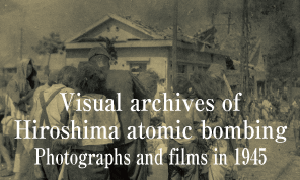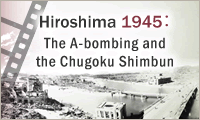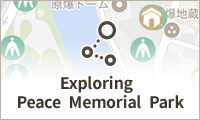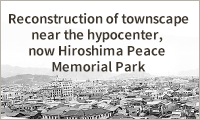Chugoku Shimbun survey confirms details of 294 A-bomb deaths at Hiroshima Second Middle School, 42% of first-year students’ remains never found
Nov. 16, 1999
On November 15, 1999, the Chugoku Shimbun reported the results of its survey, conducted with cooperation from bereaved family members, of the circumstances of the deaths from the atomic bombing of students and teachers at Hiroshima Prefectural Hiroshima Second Middle School (Second Middle School; present-day Kanon High School) who had been mobilized for building-demolition work to the former area of Nakajima-shinmachi, around 500 meters from the hypocenter. The survey revealed the detailed circumstances of the deaths of 294 such people in the atomic bombing, including 271 first-year students, 16 second-year and older students, as well as seven teachers. Of the 271 first-year students confirmed to have been victims in the bombing, 146 students, or 54 percent, died on August 6, 1945. The remains of 113 students, or 42 percent, have never been found.
The former Nakajima-shinmachi area was located on the south side of what is now Peace Memorial Park. Based on the names of the 352 people inscribed on the memorial monument for the victims erected on the west side of the park in 1961, the Chugoku Shimbun searched for bereaved family members and traced damage from the atomic bombing to each of the victims, using materials left behind by the Bereaved Families Committee of Hiroshima Prefectural Second Middle School.
On August 6, 1945, first-year students had gathered in the former Nakajima-shinmachi area, where they had been mobilized by the Hiroshima City government to engage in the sixth phase of large-scale building demolition work, based on an order from the national government. All 271 of the students, including two whose deaths were newly identified, had died by August 12, six days after they experienced the atomic bombing, except for two students—one who experienced the bombing at school in Nishikanon-machi 2-chome (present-day Kanon-honmachi 2-chome) and died in 1947, and another who was exposed to radiation when entering the city after the bombing and died in 1962. Three teachers and one second-year student who experienced the bombing at the site of work mobilization were found to have died by August 9.
The monument lists the names of 321 first-year students from six classes. The two newly identified deceased students were both transfer students—one who had been evacuated from another area, and another who had come to Hiroshima due to the father’s job or evacuation. Meanwhile, two of the students with their names on the monument turned out to still be alive. They were found to have had either been on their way to the mobilization work site or at home when they experienced the bombing, and both transferred to a new school afterward.
The circumstances of the deaths of 23 non-first-year students were also confirmed—six second-year students who had been mobilized to the East Drill Ground on the north side of Hiroshima Station, one second-year student mobilized to the Nakajima-shinmachi area, eight third- and fourth-year students and one fifth-year student who had been mobilized to the Hiroshima Machinery Works of Mitsubishi Heavy Industries, and seven teachers and school personnel, three of whom had been in the area of Nakajima-shinmachi. Twenty-one of the victims had died by November 1945, one the following year, and one in 1948.
As for the bereaved families, only 52 fathers and mothers of the deceased students were found to be alive and well. The oldest was 99 years old, and even the youngest was 83. On behalf of the parents’ generation, quite a few siblings of the late students attend the annual memorial service held each August 6 in front of the monument, with the thought, “They enrolled in their junior high school of choice but, regrettably, died without even being able to study because of the war.”
(Originally published on November 16, 1999)
The former Nakajima-shinmachi area was located on the south side of what is now Peace Memorial Park. Based on the names of the 352 people inscribed on the memorial monument for the victims erected on the west side of the park in 1961, the Chugoku Shimbun searched for bereaved family members and traced damage from the atomic bombing to each of the victims, using materials left behind by the Bereaved Families Committee of Hiroshima Prefectural Second Middle School.
On August 6, 1945, first-year students had gathered in the former Nakajima-shinmachi area, where they had been mobilized by the Hiroshima City government to engage in the sixth phase of large-scale building demolition work, based on an order from the national government. All 271 of the students, including two whose deaths were newly identified, had died by August 12, six days after they experienced the atomic bombing, except for two students—one who experienced the bombing at school in Nishikanon-machi 2-chome (present-day Kanon-honmachi 2-chome) and died in 1947, and another who was exposed to radiation when entering the city after the bombing and died in 1962. Three teachers and one second-year student who experienced the bombing at the site of work mobilization were found to have died by August 9.
The monument lists the names of 321 first-year students from six classes. The two newly identified deceased students were both transfer students—one who had been evacuated from another area, and another who had come to Hiroshima due to the father’s job or evacuation. Meanwhile, two of the students with their names on the monument turned out to still be alive. They were found to have had either been on their way to the mobilization work site or at home when they experienced the bombing, and both transferred to a new school afterward.
The circumstances of the deaths of 23 non-first-year students were also confirmed—six second-year students who had been mobilized to the East Drill Ground on the north side of Hiroshima Station, one second-year student mobilized to the Nakajima-shinmachi area, eight third- and fourth-year students and one fifth-year student who had been mobilized to the Hiroshima Machinery Works of Mitsubishi Heavy Industries, and seven teachers and school personnel, three of whom had been in the area of Nakajima-shinmachi. Twenty-one of the victims had died by November 1945, one the following year, and one in 1948.
As for the bereaved families, only 52 fathers and mothers of the deceased students were found to be alive and well. The oldest was 99 years old, and even the youngest was 83. On behalf of the parents’ generation, quite a few siblings of the late students attend the annual memorial service held each August 6 in front of the monument, with the thought, “They enrolled in their junior high school of choice but, regrettably, died without even being able to study because of the war.”
(Originally published on November 16, 1999)






